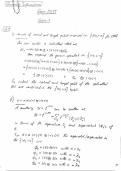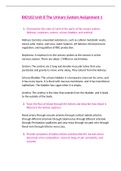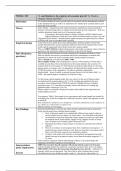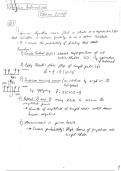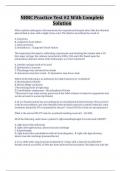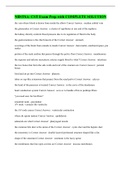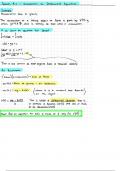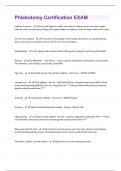PLTW CEA - Final Review Study Guide
with Complete Solutions
Compression Strength - Answer✔️✔️-The maximum compressive stress a
material can withstand without failure.
Concrete - Answer✔️✔️-A solid, hard material produced by combining
Portland cement, aggregates, sand, water and sometimes additional
mixtures.
Design Temperature Differential - Answer✔️✔️-The difference between the
indoor temperature in winter and the outdoor design temperature in
winter. The design temperature differential or design range is used in
calculating the space heating requirements of a dwelling unit under the
engineering-based methodology.
Fascia - Answer✔️✔️-The finish board covering the edges of rafters and
eaves.
Footing - Answer✔️✔️-The lowest, widest part of the foundation that
distributes the load over a broad area of the soil.
Foundation - Answer✔️✔️-The lower part of a building, which transfers
structural loads from the building to the soil.
Heat Loss - Answer✔️✔️-The energy needed to warm outside air leaking
into a building through cracks around doors, windows, and other areas.
1
, ©SOPHIABENNET@2024/2025 Monday, August 19, 2024 10:32 PM
Radiant Heat - Answer✔️✔️-Energy radiated or transmitted as rays or
waves, in the form of particles.
Rafter - Answer✔️✔️-Member of a roof structural frame that supports the
sheathing and other roof loads.
Rebar - Answer✔️✔️-Steel bar used to reinforce concrete.
R-Value - Answer✔️✔️-The numerical value used to indicate the resistance
to the flow of heat.
Sole Plate - Answer✔️✔️-The plate placed at the bottom of a wall.
Square (Quantity of Shingles) - Answer✔️✔️-In roofing, 100 square feet of
roofing material.
Tensile Strength - Answer✔️✔️-The maximum stress a material subjected to
a stretching load can withstand without tearing.
Thermal Conduction - Answer✔️✔️-The process of heat transfer through a
solid by transmitting kinetic energy from one molecule to the next.
Thermal Convection - Answer✔️✔️-Heat transmission by the circulation of a
liquid or a heated gas or air.
Transmission Load - Answer✔️✔️-Heat loss/gain resulting from the
conduction of heat through the building envelope.
U-Factor - Answer✔️✔️-A measure of the heat transmission through a
building part (as a wall or window) or a given thickness of a material (as
insulation) with lower numbers indicating better insulating properties.
2

